Women in IT: Building Opportunities in European Tech

Information technology (IT) drives the European economy and innovation. However, despite the many opportunities that IT presents, women are still not significantly present in this field. Why?
This article aims to analyze the current state of women in IT in Europe, the challenges they face and ongoing initiatives aimed at closing the gender gap. We'll highlight existing statistics, potential legislative solutions, and the real-life experiences of women in tech.
Women in Tech: Making History
The story of women in technology begins long before the modern era.
19th Century
Going back to the 1800s, a famous example is Ada Lovelace, an English mathematician and writer, who wrote the first computer program. Her work helped to lay the foundation for the development of modern computers.
20th Century
Later in the 1990s, other examples of women played an important role in shaping the technological landscape.
They are Grace Hopper, who developed the first compiler for a computer programming language, and Hedy Lamarr, who co-invented a frequency-hopping spread-spectrum communications system that underlies the secure communication methods used in Wi-Fi. Fi, Bluetooth, and GPS.
Katherine Johnson is an American mathematician who played a key role in NASA's first space missions. Her calculations were essential to the success of the Apollo 11 mission, which landed the first men on the moon in 1969.
Sister Mary Kenneth Keller was an American computer scientist, educator, and Catholic nun. and the first person to receive a doctorate in computer science in the United States. She also helped shape the curriculum for computer science programs in universities throughout the country.
21st Century
A prominent figure in the technology industry is Marissa Mayer, known for her leadership in search engine optimization and user experience design, she was the CEO of Yahoo and an executive at Google, initially serving as the company's first female software engineer.
Another notable figure is Reshma Saujani, founder of Girls Who Code, which aims to support and increase women's participation in technology and provides young girls with the opportunity to learn coding and other technology skills.
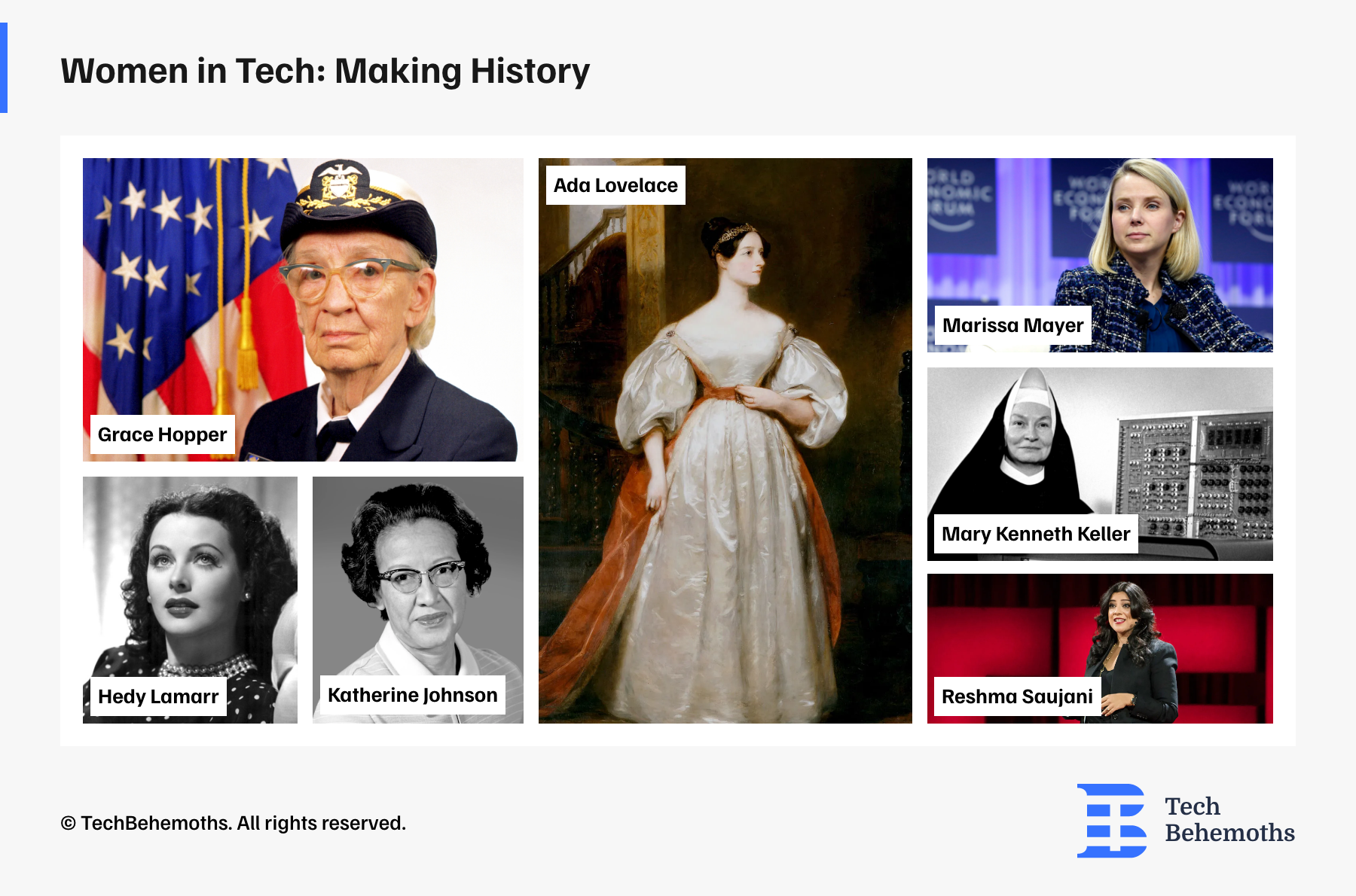
These are some of the most iconic examples of the many women who have made significant contributions to the field of technology. Their stories are truly inspiring and support the importance of inclusion and diversity in the tech industry.
Women in Tech in the EU
Despite these historical contributions, the European tech sector, like many others, still faces a gender gap. According to a European Commission report, only 32.8% of people employed in high-tech sectors in the EU are women. This indicates a notable underrepresentation compared to their male counterparts.
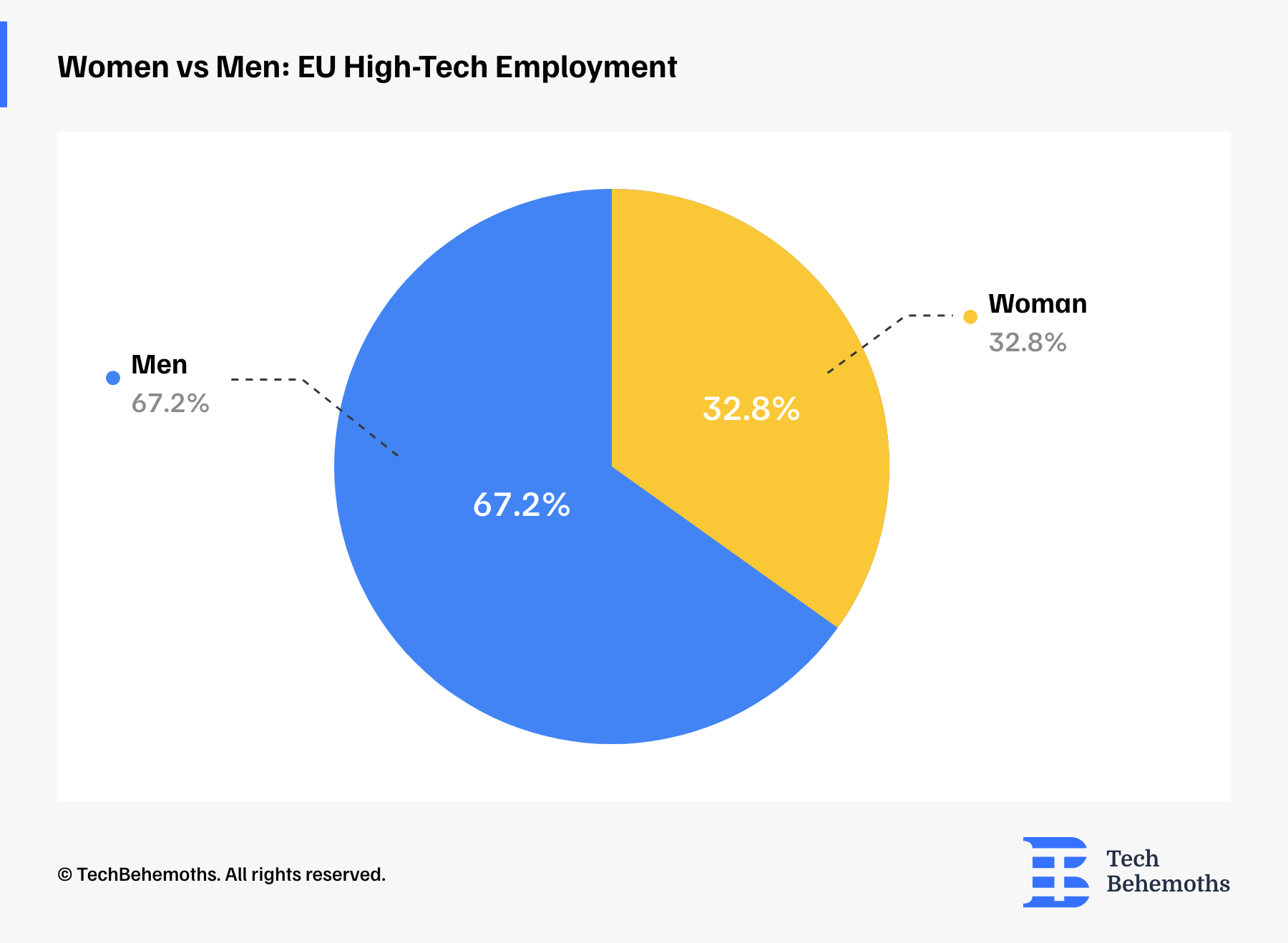
EU's Initiatives Closing Tech's Gender Gap
Recognizing the need for change, the EU is taking action to close the gap. Even though there is no specific legislation aimed exclusively at empowering women in the tech industry, there are several initiatives that contribute to a more inclusive environment and support women in tech careers. Here are some of them:
Women TechEU program
The Women TechEU program, launched on 13 July 2021 by the European Commission, supports women-led deep-tech startups by offering financing and business acceleration services. As of 2023/2024, the Women TechEU program will be managed by an external consortium.
European Women in Technology Event
Events like European Women in Technology aim to empower women in technology by encouraging a sense of community, inspiration, and connection. In June 2024, the 7th edition will unite a community of more than 4500 women to explore the possibilities of the tech industry.
EIC Women Leadership Program
Initiatives such as the EIC Women Leadership Program undertaken by the European Union target female leaders from the EIC and EIT communities to strengthen their leadership skills, expand their startups or businesses, support female researchers involved in research projects, presenting them as role models for women leaders in deep technology. As of 2024, applications are being accepted for the 5th cohort.
The European Digital Skills Awards
An initiative by the European Commission to recognize and promote projects that help Europeans develop digital skills. This Award includes a dedicated category called "Women in ICT Careers." This category aims to increase the number of female ICT professionals and enhance the digital skills of women currently in the workforce and younger women in digital technologies.
The Gender Equality Strategy
The European Commission's strategy for gender equality 2020-2025 sets out various actions to promote equal opportunities for women and girls in all aspects of life, including the tech industry. This includes promoting STEM education for girls, encouraging women to pursue careers in tech, and supporting female entrepreneurs in the tech sector.
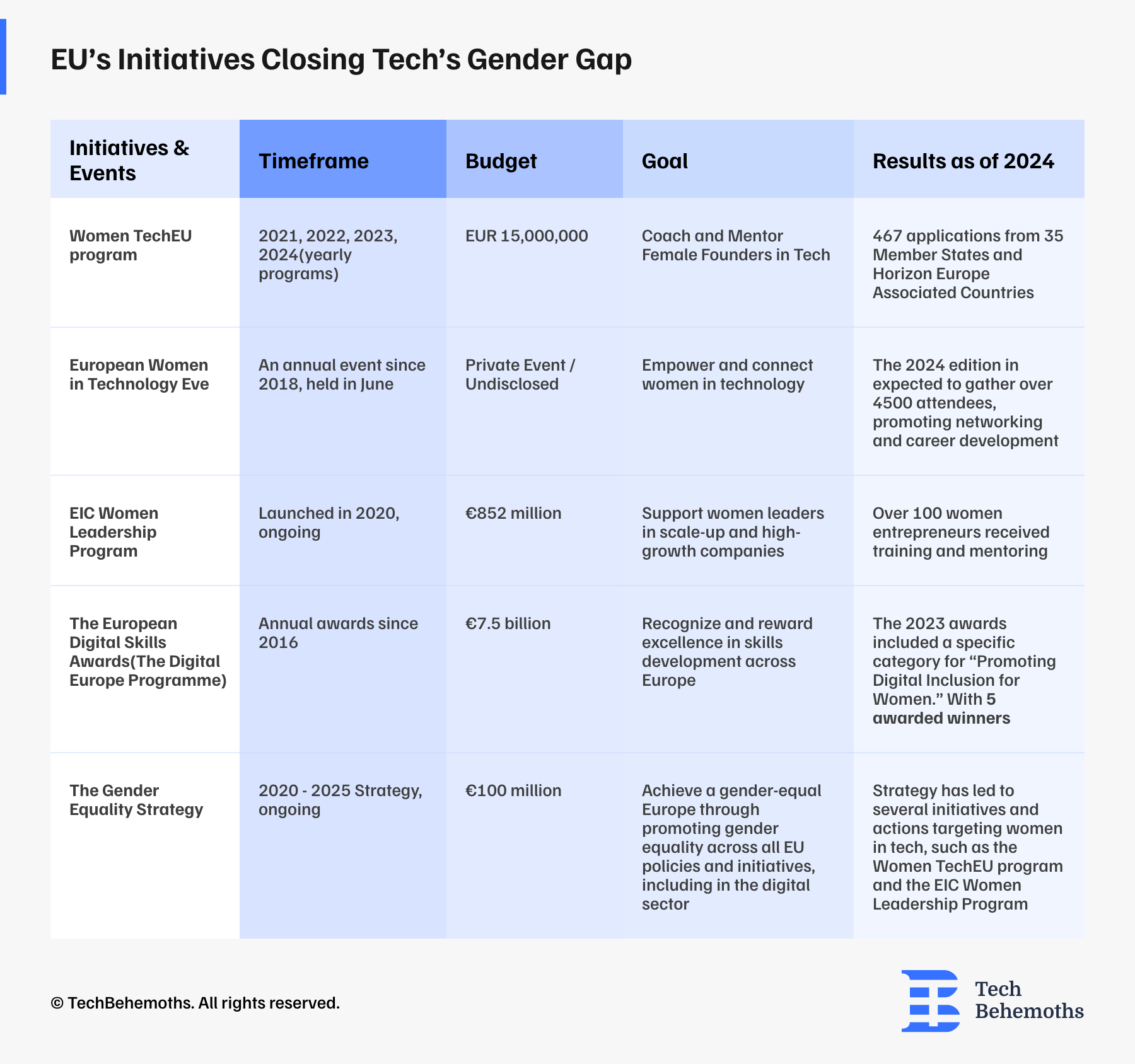
President of the European Commission, Ursula von der Leyen, said:
“Gender equality is a core principle of the European Union, but it is not yet a reality. In business, politics, and society, we can only reach our full potential if we use all of our talent and diversity. Using only half of the population, half of the ideas or half of the energy is not good enough. With the Gender Equality Strategy, we are pushing for more and faster progress to promote equality between men and women.
EU Countries: Highest and Lowest Women Tech Employment Levels
Globally, only 47.7% of women are in the labor force, less than half, and some countries have even lower participation rates. This would mean that for every two men employed, there is only one woman. The regions with the lowest levels of gender parity in labor force participation are the Middle East and North Africa (30%) and South Asia (34%). North America leads with the highest score of 84%, followed closely by Europe at 82%.
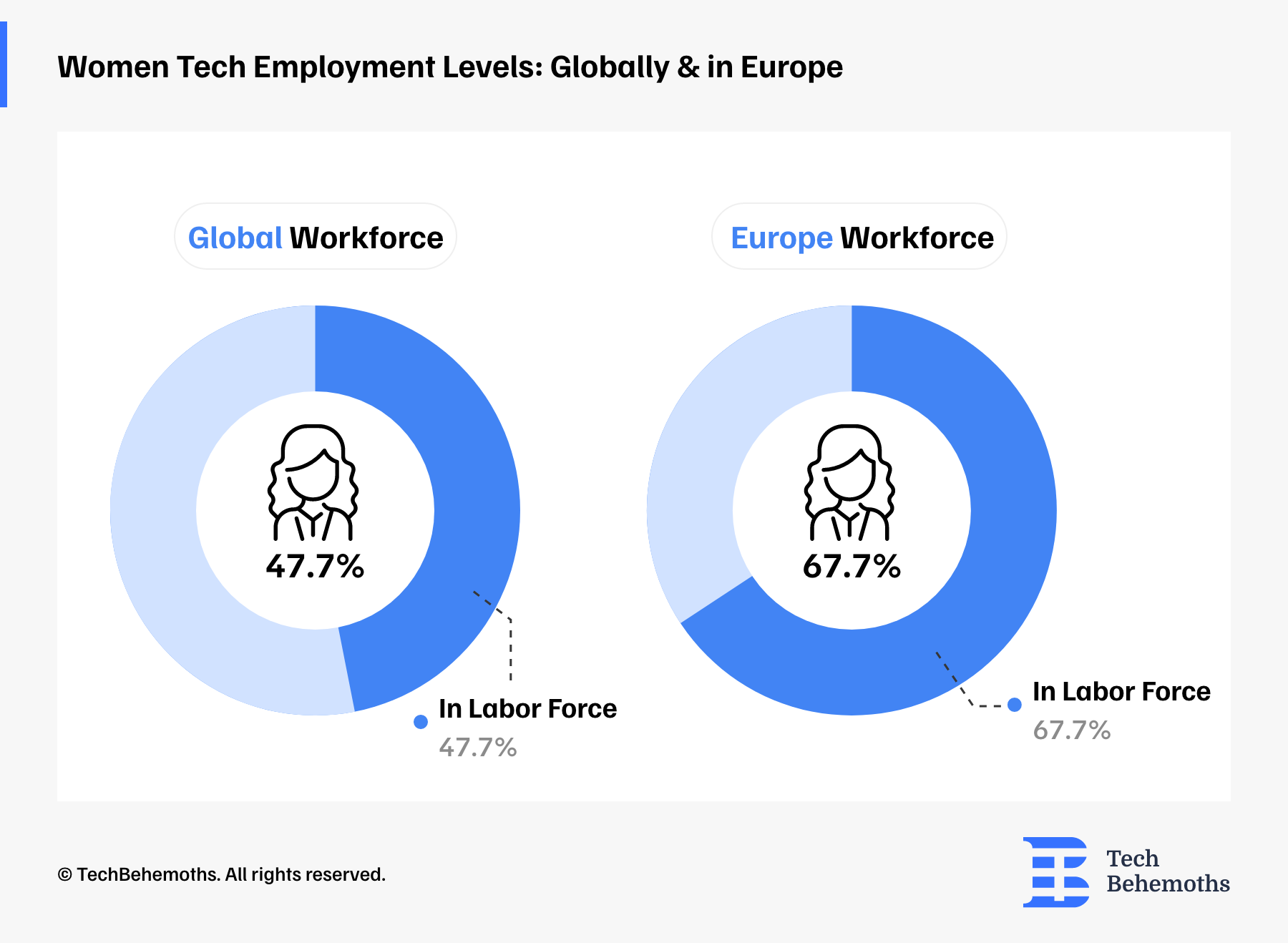
If we consider the share of women employed in ICT, here are the countries in Europe with the highest and lowest number of women employed in Information and Communication Technology.
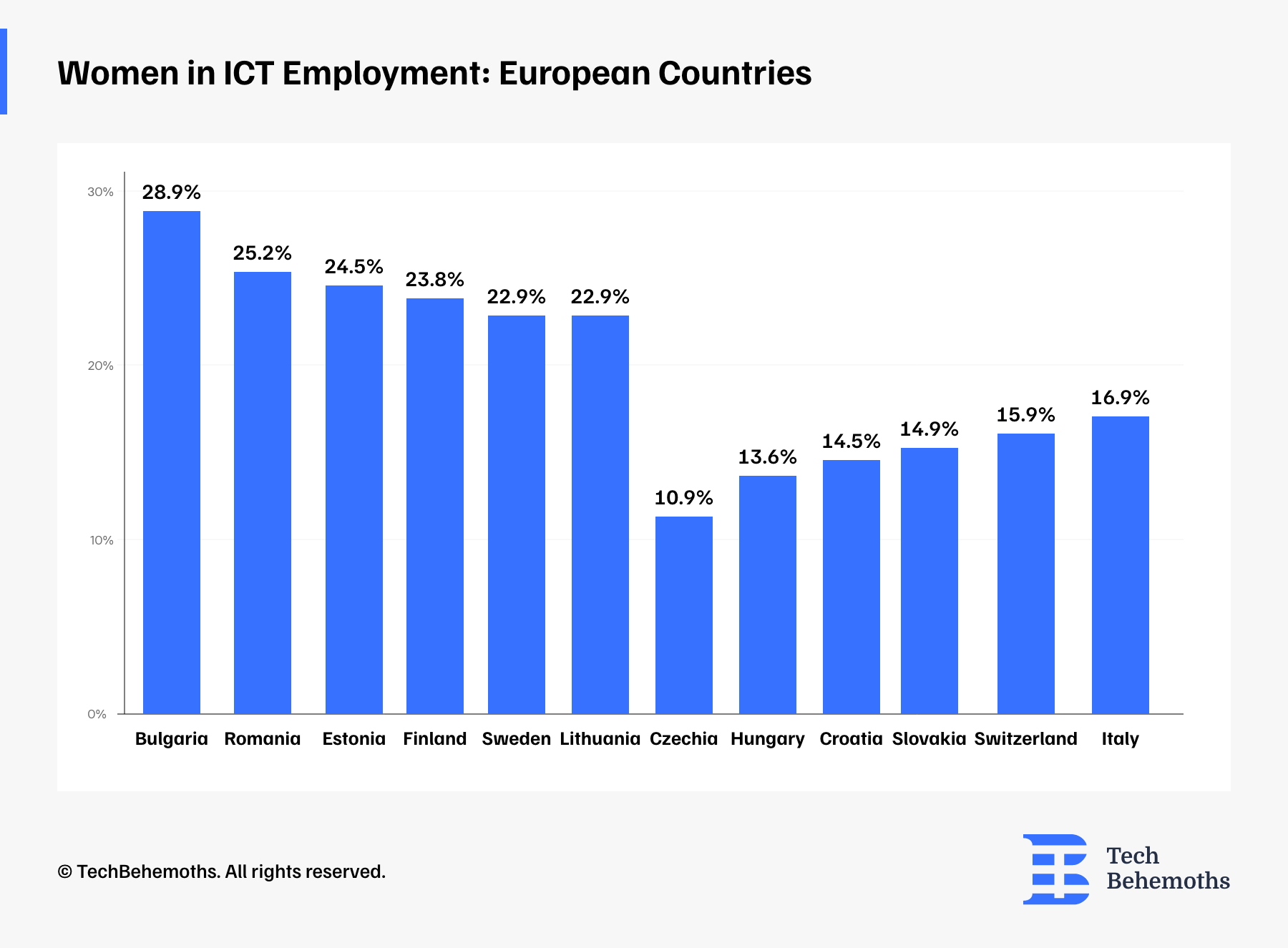
As we can see, the Eastern European countries dominate the first positions: Bulgaria, Romania, and Estonia all have weights exceeding 24.5%, indicating a considerably higher presence of women in ICT specialist roles compared to other regions.
The Nordic countries of Finland, Sweden, and Lithuania are in the top six, but still suggest a lower representation of women in this field. Several countries in Western and Central Europe, including the Czech Republic, Hungary, Slovakia, Switzerland, and Italy, rank last, with shares below 17%.
This data highlights the need for new European initiatives to encourage and empower women to pursue a career in the ICT sector.
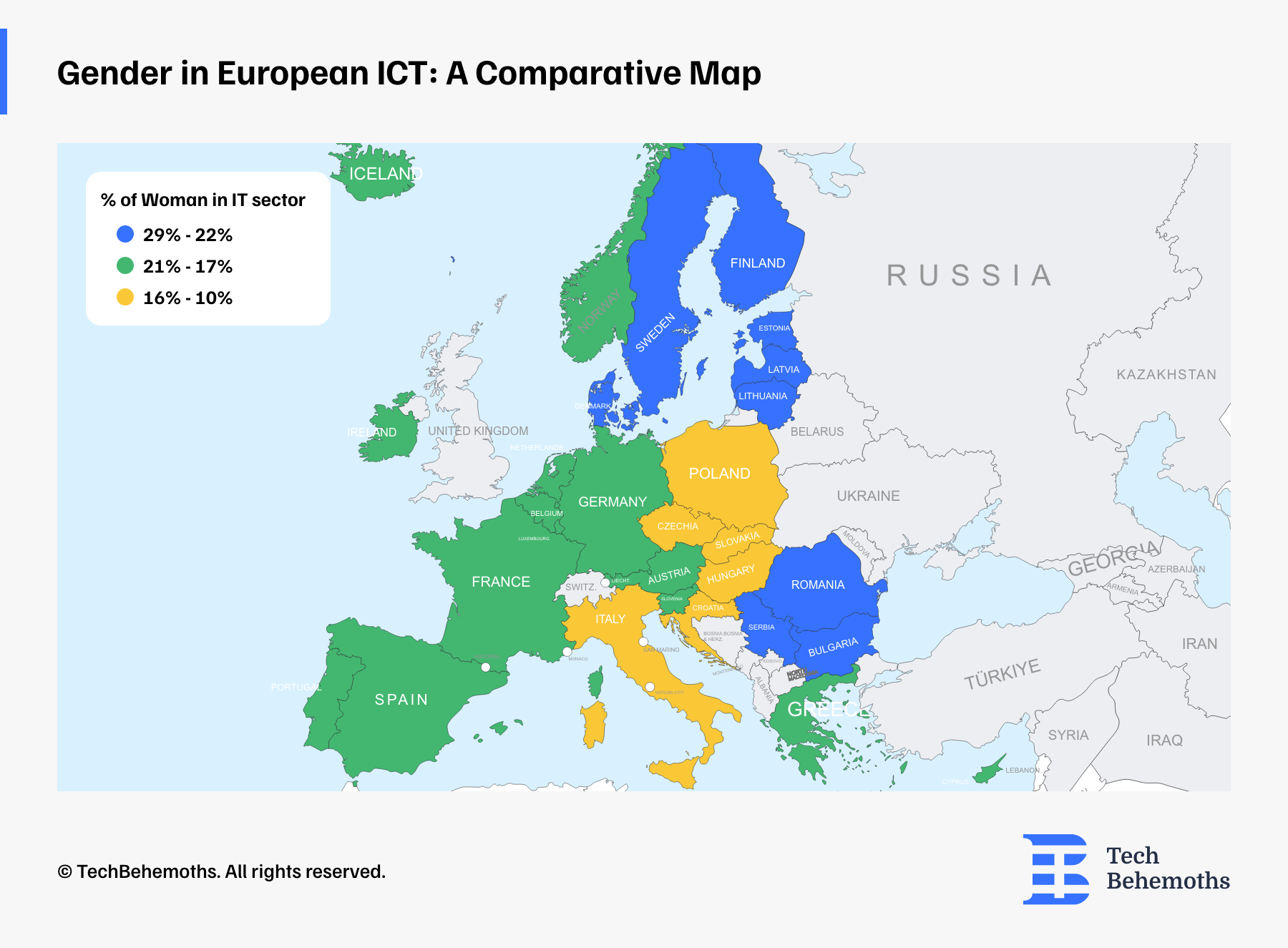
Women in Tech Jobs Across Europe
The EU tech industry still lacks gender diversity. However, certain IT jobs have a higher percentage of women than others. In the following, we will present the most and least in-demand positions for women in the industry.
According to a report by McKinsey & Company, women are highly represented in product design and management roles at 46%. This is followed by data engineering, science, and analytics roles at 30%, and IT consulting roles at 22%.
However, the report also highlights that women are least represented in DevOps and cloud roles, with an average share of just 8%. Furthermore, they are also underrepresented in core engineering roles at 18%, and computing and operations roles at 15%.
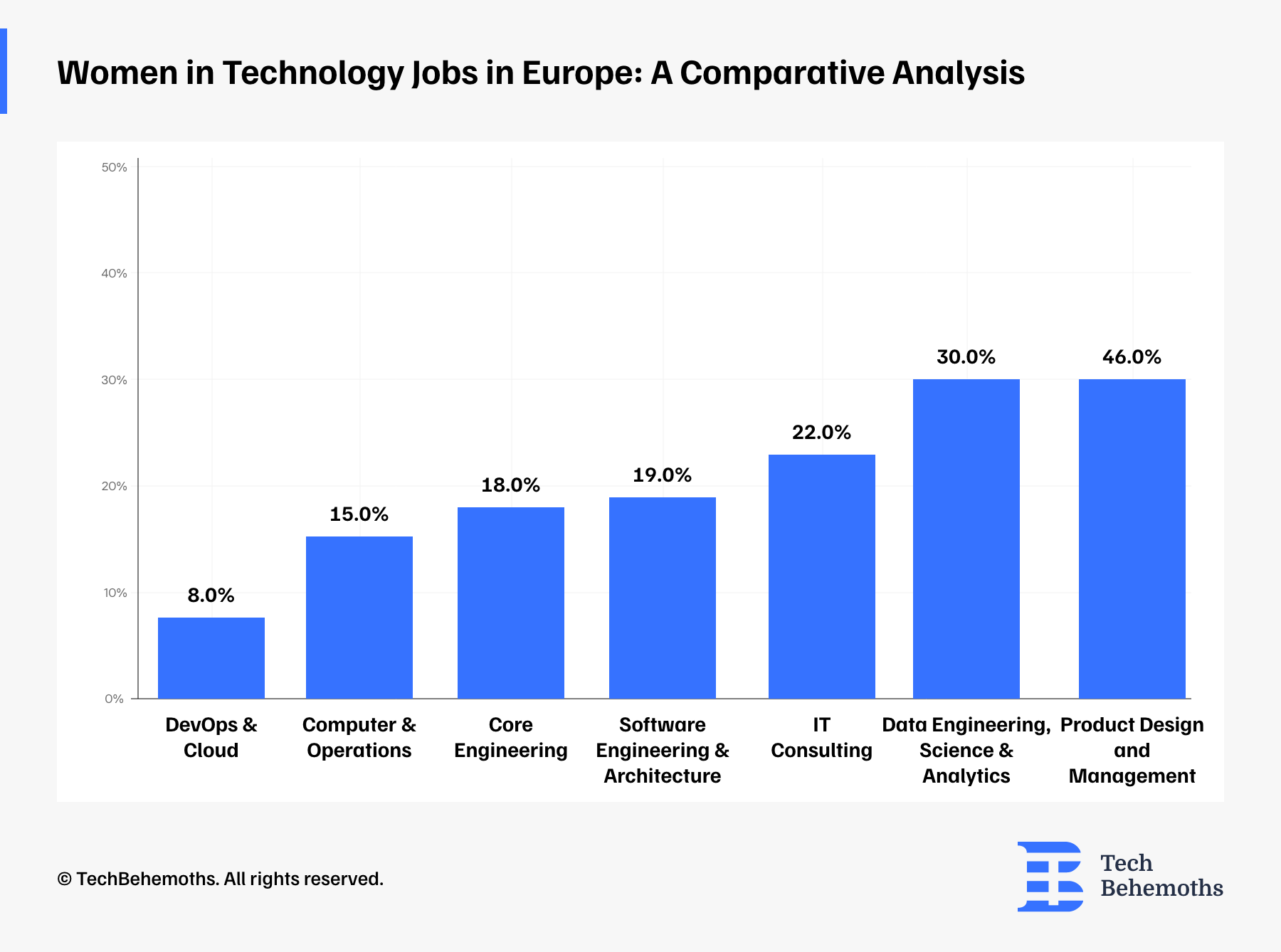
Roles With More Women Involved
User Experience Designer (UX Designer)
This field has seen an increasing number of women entering the workforce. It focuses on the user experience when interacting with a product, ensuring it is easy to use, efficient, and enjoyable.
Product Designer
This role has also seen an increase in female participation compared to other tech fields.
A product designer creates the visual look and feel of a product, taking into account user needs and branding.
Product Manager
The number of women in product management is steadily increasing. A product manager oversees the entire lifecycle of a product, from conception to launch and beyond.
Roles With Fewer Women Involved
DevOps Engineer
This is a traditionally male-dominated field, with efforts to attract and retain more women. DevOps Engineers automate the software development, deployment, and operations process.
Cloud Engineer
Similar to DevOps, cloud engineering is a field with a lower percentage of women compared to the general technology industry. Cloud Engineers design, build, and manage cloud-based infrastructure.
Site Reliability Engineer (SRE)
A site reliability engineer ensures the reliability, scalability, and performance of software systems in production. This is another area with a significant gender gap, with initiatives being taken to encourage more women to pursue careers in SRE.
As we can observe roles involving more women often prioritize creative thinking and problem-solving skills. These are often associated with user experience, which requires a deep understanding of the user's needs and preferences. While those with male predominance require more technical expertise and a significant amount of technical knowledge.
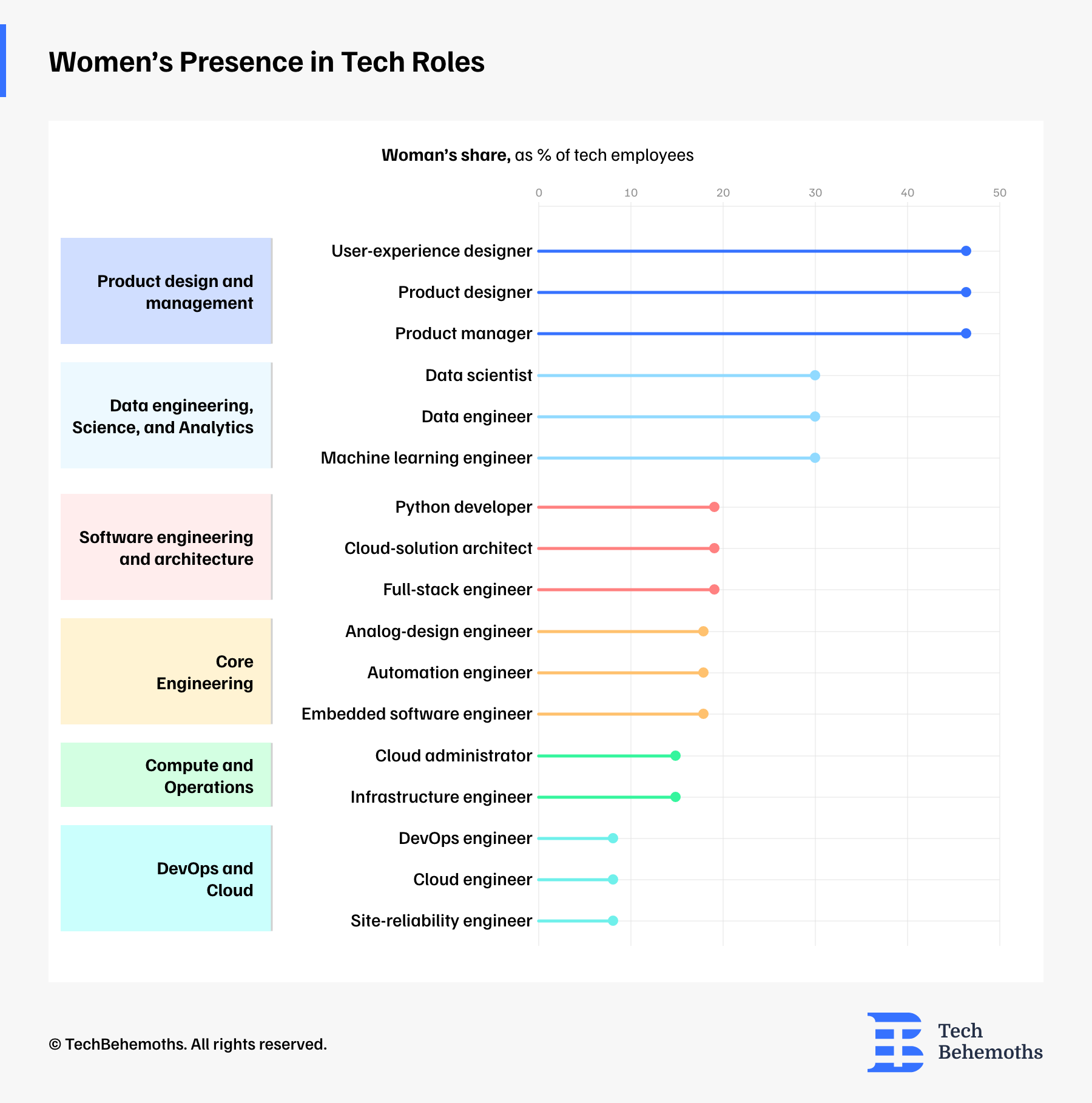
Women in EU IT Companies
In the same vein, it is curious that the IT companies that employ more women fall into several groups, with
-
Social media and e-commerce and payments companies have the highest average share of women across all functions, at 50% and, 46%.
-
Technology companies follow with 37%.
-
The lowest average share of women across all functions, at 24% and 31%, is in semiconductor engineering and manufacturing companies.
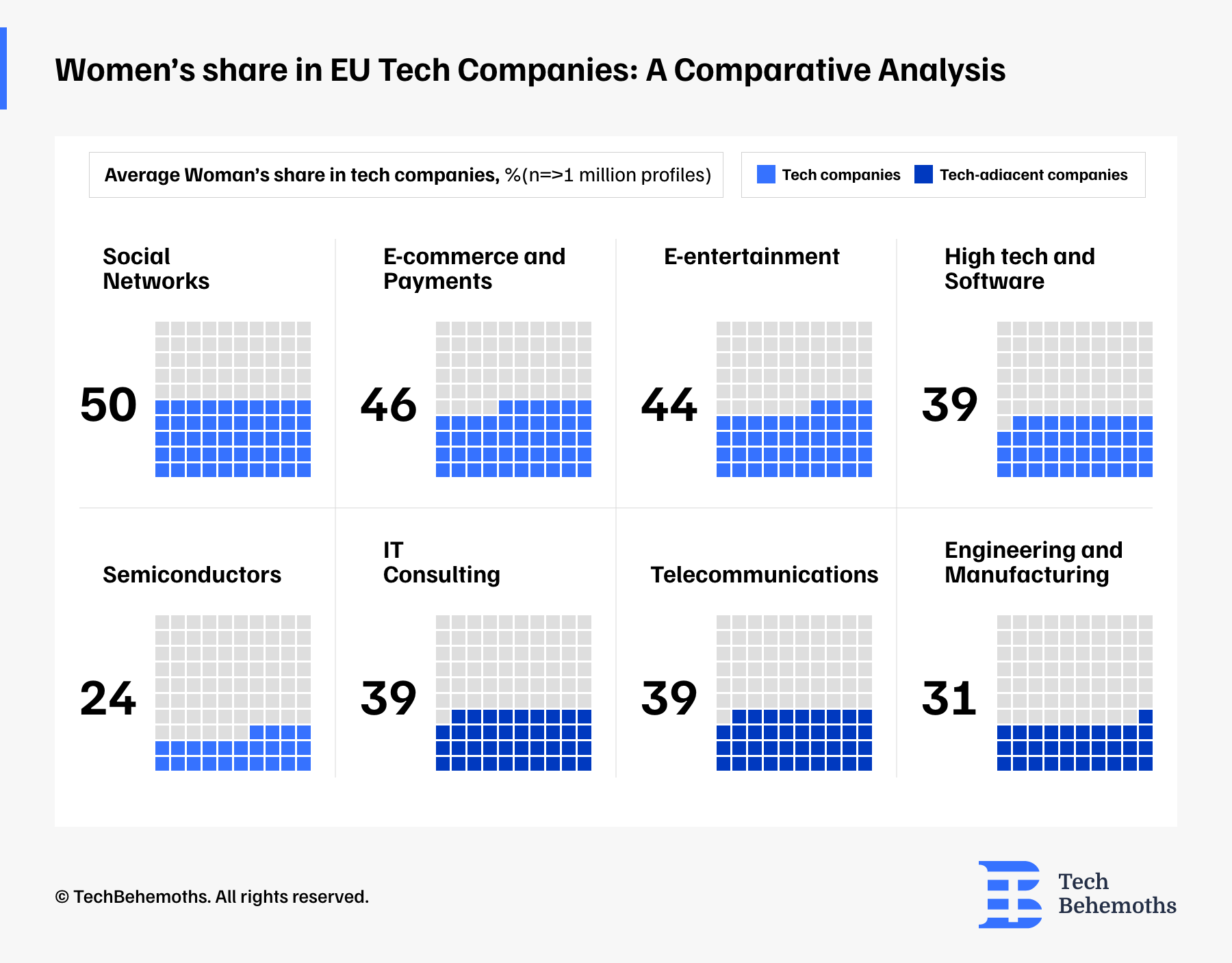
According to the Ravio Compensation Report for 2024, only 19% of executives in Europe's growing start-up scene are women, 35% of women hold managerial positions, and 41% of professional roles in the tech sector. Interestingly, women are most highly represented in support roles, making up 61% of those positions.
This finding highlights that women are underrepresented in higher-paying executive positions, while men predominate in them, which also suggests the tech pay gap between men and women. Let's further analyze their salary differences!
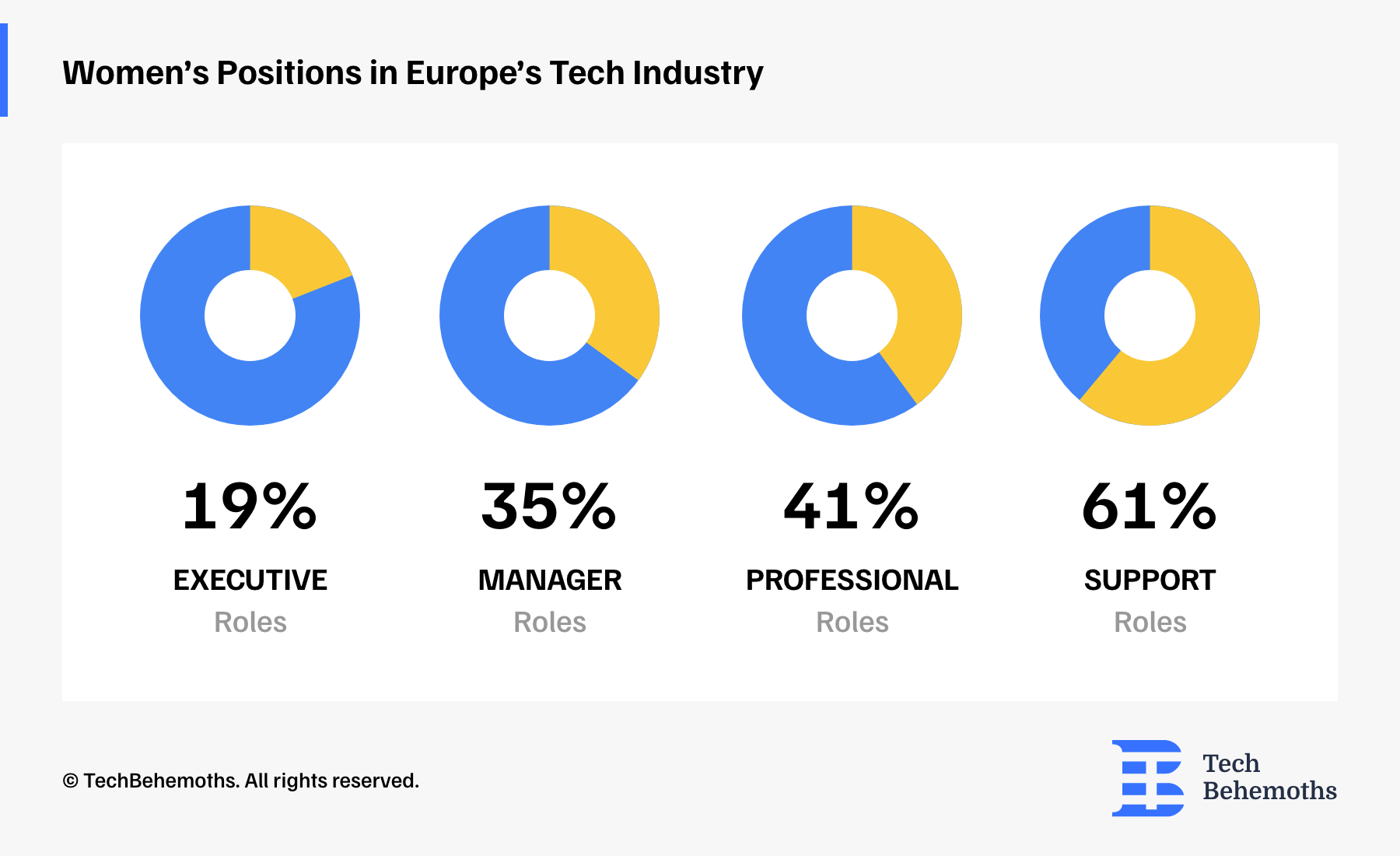
Gender Salary Gap in Tech
As we might already guess, women in tech positions are getting paid less than men. Studies show they're earning 19-26% less than their male colleagues.
When we look at the numbers, it becomes apparent that the pay gap between women and men varies from country to country. Some places face a wider gap, while others appear to be making progress.
According to Ravio and Eurostat report, the UK tops the list with a gap of 29%, followed by Germany at 25%, the Netherlands at 23% France at 18%, Hungary, and Austria at over 17% and less than 5% in Luxembourg, Romania, Slovenia, Poland, Belgium, and Italy. It should be noted that compared to 10 years ago, women are getting closer to earning the same as men.
The reasons for this gap are complex, but a few of them are the low number of women in senior positions, women may be less likely to negotiate salaries as do men, and even often not realize or recognize many stereotypes can influence hiring, promotion, and salary decisions, even if unintentional.
On the other hand, according to women across IT companies based in the EU, the gender salary gap is practically nonexistent. This is confirmed by women employed in IT companies that we surveyed when writing this article.
“Salary in our company is strongly correlated with employee progression, ambition, results and experience. Not with gender.”
Natalia Sokolova, DevFamily, Estonia
The same thing is confirmed by Yanina Mizernyuk from Acropolium, Czechia:
“There aren't any differences in salaries between men and women on our team”
In Bulgaria, women in IT companies were also inquired on this matter, and there seems to be no difference in experiencing gender pay gap according to them:
“I cannot speak definitively regarding broader trends in the IT industry, but within our company, gender does not influence salary differentials. Compensation is determined holistically, taking into account factors such as professional expertise, experience, contributions to workflow, and demonstrated performance”
Milena Vasileva, Presitely, Bulgaria
The identical conclusion is affirmed by Natalie Bilynska from NERDZ LAB, Ukraine:
Salaries are determined based on market wages for the position and years of experience, using data from sources such as DOU and Djinni. This applies to all employees, regardless of gender, so there are no salary differences.
Gender Gap - Career Advancement in IT
The gender gap is not always limited to wages, but it also touches the career advancement aspect. In some countries, companies, and cultures, leadership roles are being held by men either entirely or more than 50%.
The National Bureau of Economic Research, USA issued a report that mentions how women underrate their performance compared to men. In addition, a report from Frontiers in Psychology has shown that, when being considered for a managerial position or a promotion, men are evaluated based on their vision and potential, while women are evaluated based on their past contributions.
Fortunately, the EU has been fighting this phenomenon, and companies have already a different vision on this topic in most of the member countries.
“Having been with the company since its foundation, I can say that it's never been an issue.”
Milena Vasileva, Bulgaria
This statement is also supported by other women employed in the IT sector across the EU. In Czechia, career advancement seems to be merit-based and an objective process that happens to both women and men.
“I've never had any problems with promotions on our team. We have a positive workplace environment where promotions are perceived as fair and merit-based.”
Yanina Mizernyuk, Czech Republic
Outside the EU though, the gender gap in career advancement is relying on national practices, traditions, and if the legal framework allows, on the management’s decision. So, the opportunities to advance as a professional in a company could be equal or even lower compared to those in the EU.
Nonetheless, in the UK, which is no longer a part of the EU, IT companies provide equal opportunities to men and women alike in case of promotions. Lana, a professional currently employed in a UK tech company, states:
“Our company is woman-led, and it is not difficult to advance as a woman in our company provided the person has the required skills”
Lana asked to keep her answer anonymous, as well as the company she is working at, therefore more information cannot be provided.
Closing Thoughts
Women have left a remarkable mark on the tech industry, from historical figures to modern leaders. Their tech journey is one of the impressive achievements but also persistent challenges, including unequal representation in certain tech roles and a gender pay gap.y gap.
Closing this gap requires continued efforts to promote diversity, support female leadership, and address unconscious biases. By doing so, Europe can create a more equitable and innovative tech sector where women are empowered to succeed alongside men.